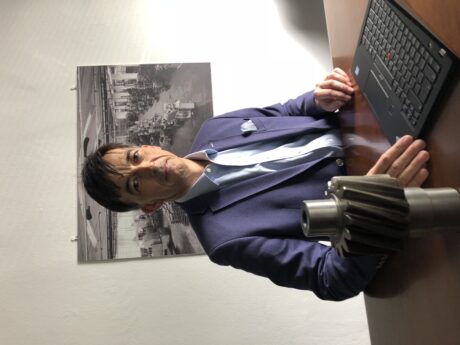More and more relevant in the supply chain, the role of the gear manufacturer must suit new market dynamics that impose high product quality, but also high added-value support and service competences in various functional areas. A clear interpretation of the topic is given by Lorenzo Cattini, Chairman and C.E.O. of Cattini e Figlio at Casarile (Milan, Italy).
Part of the wider and diversified engineering sector, the production segment of the power transmission components constitutes an important element of the Italian manufacturing industry, both in terms of generated revenue and employed people, as well as an accelerating factor of economic growth. A centre of excellence consisting of companies that can provide technical skills, know-how, production capacity and high added-value services, with excellence levels that are, in some cases, acknowledged on a global scale. One of them is Cattini e Figlio, a renowned custom gear manufacturer, specialist in all major types of gears (from external/internal spur gears to spiral/hypoid bevel gears to manual or power shift gear shifting systems), a company that has been able to play an increasingly important role in its core market segments, basing on differentiating factors that have characterized Its over 70 years of history and growth.

«Differentiating factors – explains the Chairman and C.E.O. Lorenzo Cattini – that reside not only in the technologies and processes adopted but also in the not easy task, as a subcontractor, of succeeding in assuring customers a high level of satisfaction in the areas of quality, services, technology and costs. In short, an excellent supply experience, summarised by the acronym T.P.E. (Total Procurement Experience). What distinguishes an average company from an excellent one, considering the context in which we operate – subcontracting – is the capability of fully interfacing with customers. When I say full, I mean the capability of acting as a global co-ordinator, a “bonder”, between different areas of big corporations as the major global manufacturers of professional, heavy vehicles like agricultural tractors, trucks and construction machinery, whose complex organizational structures (procurement, product and process engineering, quality, safety and environment) require important co-ordination efforts to get the job done».
The integration of functions that generates value
So, there are many areas – each one with its own issues – with which a subcontractor has to interact. Some are well known, others not always deemed essential.
«In the choice of a supplier, of a subcontractor – Cattini observes – the final and most obvious process owner is the procurement department, which takes care to summarize the engineering, quality, logistic and wavelength evaluations received from within its organization. The wavelength evaluation becomes more and more critical but also more difficult to express because it is essentially a subjective evaluation. Integrating all of these functions at best becomes then more importan than ever, because only in this way it is possible to reach the highest competitiveness and secure the victory against the fiercer competitor that is, in our context, the customer itself!».
To pursue this goal, Cattini e Figlio has established some local branches in strategic areas: in February 2018, Cattini North America at Chambersburg (PA) has been incorporated with the goal of supplying North American customers with an even better logistic and after-sale support; the subsidiary Cattini Power Transmission Pvt. Ltd was instead set up in India in 2019 to start a local production of highly required components. Both are part of a high added value strategy that is aimed at generating value for customers and secure their loyalty.
«From my point of view – Cattini adds – this is another challenge to be accepted by an Italian company that intends to excel in the subcontracting segment: endlessly generating value for its customers and, obviously, making customers aware of this value. At the same time, it is expected to be very dynamic and fast in taking decisions to quickly adapt or, even better, to prevent the evolution of the market».
Despite the almost 300 employees and a relatively complexed organization, Cattini e Figlio is a lean and agile company, with the aim to assure the highest reaction speed on the entire supply chain.
The essential value of human capital
It is crucial, to suit at best the ever changing market dynamics, to be able to count not only on state-of-the-art technologies and on an appropriate organization but also on a first class human capital.
«The subcontractor of excellence of the future – Cattini confirms – to remain competitive on the market must also be able to recognize the crucial importance of the human capital’s value. I believe that for the next 8-10 years, the capability of paying even more attention to the team, to his motivation, training and education will play a determining role in the industry. This will be achieved not only by means of the traditional training courses but also with a real high-level coaching».
In the opinion of Cattini, even if in big companies this might seem more complex, the winning base concept remains the same, and always oriented to provide customers with an excellent supply experience.
«Customers’ purchase experience – Cattini ends – must be so excellent as to induce them to believe in the added value the subcontractor can give, and then to become aware of the possibility of focusing their resources and investments elsewhere, not being committed anymore to in-house gear manufacturing. This concept must be boosted by a global vision of developing an excellence cluster, in promoting a group of excellent companies that can be recognized in the world, because, in the long term, only a victory of the team is possible! Assiot, as the gear manufacturers association, is making lots of efforts to consolidate successfully this Italian reality. With this vision and with a continuous improvement stimulus generated by a constructive comparison with the competition, we believe that the role of the gear manufacturer can prove to be crucial in the supply chain now and for the foreseeable future».





